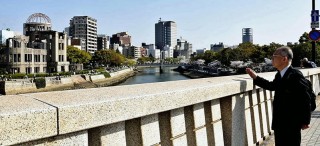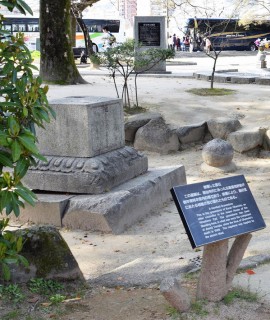Loading
Search
▼ Hiroshima Panel Creates App For ‘Peace Tourism’
- Category:Tourism
HIROSHIMA — A panel of experts working with Hiroshima city has created peace-themed tour routes that will be accessible via an app, as part of a “peace tourism” project aimed at visitors to the city.
Under the project, the municipal government has proposed routes for “peace tours” and embarked on the creation of an app that will allow bombed buildings to be seen through an augmented-reality (AR) system, thereby taking visitors around the city’s landmarks.
I walked along one of the planned routes with the panel’s chief, Hiroshi Harada, 78, a former head of the Hiroshima Peace Memorial Museum. He is also an atomic bomb survivor.
I selected the route around the Hiroshima Peace Memorial Park in Naka Ward. This 2.5-kilometer route takes three hours to complete and includes buildings showing traces of the atomic bombing in 1945.
Sites on the route include the Atomic Bomb Dome, the Honkawa Elementary School Peace Museum, a gravestone damaged by the blast in what was once in the compound of the Jisenji temple in the peace memorial park, the Rest House in the park, the former building of the Bank of Japan’s Hiroshima branch, and the Fukuromachi Municipal Elementary School’s Peace Museum.
Honkawa school peace museum
After leaving the Atomic Bomb Dome, I crossed the Aioibashi bridge over the former Otagawa river. I found the streets fairly empty. Because the entrance to the Honkawa Elementary School building is on the opposite side of the park, many people do not know there is a museum inside.
“After seeing the Atomic Bomb Dome, I think many people walk through the park to the cenotaph for atomic bomb victims or the Hiroshima Peace Memorial Museum,” an official of the municipal government said.
According to the Hiroshima city board of education, the number of visitors to the Honkawa museum was about 27,000 in fiscal 2017, which is less than 2 percent of the about 1.68 million visitors to the Hiroshima Peace Memorial Museum.
“The main building of the Hiroshima Peace Memorial Museum is closed right now. So it’s important to have visitors go to places where the belongings of atomic bomb victims and other real objects are displayed,” Harada said.
Under the project, the municipal government has proposed routes for “peace tours” and embarked on the creation of an app that will allow bombed buildings to be seen through an augmented-reality (AR) system, thereby taking visitors around the city’s landmarks.
I walked along one of the planned routes with the panel’s chief, Hiroshi Harada, 78, a former head of the Hiroshima Peace Memorial Museum. He is also an atomic bomb survivor.
I selected the route around the Hiroshima Peace Memorial Park in Naka Ward. This 2.5-kilometer route takes three hours to complete and includes buildings showing traces of the atomic bombing in 1945.
Sites on the route include the Atomic Bomb Dome, the Honkawa Elementary School Peace Museum, a gravestone damaged by the blast in what was once in the compound of the Jisenji temple in the peace memorial park, the Rest House in the park, the former building of the Bank of Japan’s Hiroshima branch, and the Fukuromachi Municipal Elementary School’s Peace Museum.
Honkawa school peace museum
After leaving the Atomic Bomb Dome, I crossed the Aioibashi bridge over the former Otagawa river. I found the streets fairly empty. Because the entrance to the Honkawa Elementary School building is on the opposite side of the park, many people do not know there is a museum inside.
“After seeing the Atomic Bomb Dome, I think many people walk through the park to the cenotaph for atomic bomb victims or the Hiroshima Peace Memorial Museum,” an official of the municipal government said.
According to the Hiroshima city board of education, the number of visitors to the Honkawa museum was about 27,000 in fiscal 2017, which is less than 2 percent of the about 1.68 million visitors to the Hiroshima Peace Memorial Museum.
“The main building of the Hiroshima Peace Memorial Museum is closed right now. So it’s important to have visitors go to places where the belongings of atomic bomb victims and other real objects are displayed,” Harada said.
Former compound of Jisenji temple
We went back to the peace memorial park, and headed for the former compound of the Jisenji temple, which is close to the Children’s Peace Monument. But it was not easy to find the next site, the gravestone.
With Harada’s help, I found it — the capstone was knocked off by the atomic blast — on a lower level surrounded by stones.
“This site wasn’t depressed. This is actually the level of the former Nakajima-Honcho area before the bombing,” he said.
I would have passed by the site if not for his guidance. But when I looked carefully, I saw that the park was built on top of this spot where the atomic bomb deprived people of life.
There is a plaque with a simple explanation of the facts in Japanese and English set beside the stones.
I thought more visitors might step down to look at this site if the plaque had a more detailed explanation.
Take a walk
In 2016, about 12.61 million tourists visited the city, with foreign nationals accounting for about 1.17 million of them. Both figures were new record highs. However, nearly half of the foreign visitors visited Hiroshima on day trips.
The municipal government wants foreign visitors to stay in the city longer and visit more places so that they can share in the city’s hopes for peace.
There is also an eight-hour bus tour, but it is necessary to figure out ways to allow visitors to tour the area more flexibly.
A member of the panel said at the meeting, “We need to create an environment in which each Hiroshima citizen can speak about Hiroshima in their own language and show visitors around the city.”
Harada said: “We have many visitors from elsewhere. To make such visitors understand the importance of peace, it’s important that Hiroshima’s citizens, including young people, know about the city,” Harada said.
Panel carefully planned routes
The expert panel was launched in June last year, and the members have spent about one year outlining tour routes and their approaches.
The panel categorized about 53 locations in Hiroshima Prefecture related to peace, such as memorial monuments and remains from the bombing, into four themes: bombed structures; culture and literature before and after the 1945 atomic bombing; the revival of public life; and bombing-related memorial museums. The sightseeing tours can be taken by bicycle, bus or on foot.
At the end of fiscal 2017, the panel proposed promoting information about the reality of atomic bombings, getting citizens to actively participate in peace tourism and improving things like rest houses and explanatory boards at sightseeing locations.
The panel told Hiroshima Mayor Kazumi Matsui: “We’ll offer hospitality to visitors to make them feel, ‘We’re glad we came to Hiroshima.’ Sending out a message of peace will lead to the vitalization of Hiroshima.”
The municipal government plans to create a map showing the tour routes as well as the new app. App users will be able to see pictures of how the city looked before it was bombed, along with captions, by holding their smartphone up toward the bombed structures and others.
The panel told Hiroshima Mayor Kazumi Matsui: “We’ll offer hospitality to visitors to make them feel, ‘We’re glad we came to Hiroshima.’ Sending out a message of peace will lead to the vitalization of Hiroshima.”
The municipal government plans to create a map showing the tour routes as well as the new app. App users will be able to see pictures of how the city looked before it was bombed, along with captions, by holding their smartphone up toward the bombed structures and others.
- May 28, 2018
- Comment (0)
- Trackback(0)




